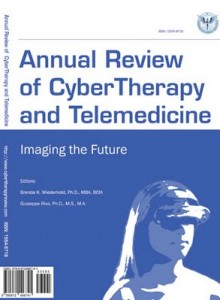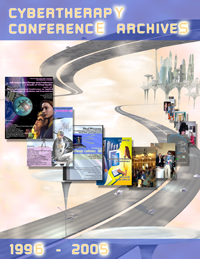A wide range of Academic Publications
IMI and its partner organizations offer a wide range of academic publications that outline the advantages of using cybertherapy for cognitive-behavioral, neuropsychological, and physical assessment and intervention applications. Please contact us or visit www.vrphobia.com to order. Many books are also available now on this website under the Shop button.

Annual Review of CyberTherapy and Telemedicine
Volume 1, 2002 – Volume 5, 2007
Transforming Healthcare Through Technology
Prof. Dr. Brenda K. Wiederhold, PhD, MBA, Prof. Stephane Bouchard, Ph.D., and, Prof. Giuseppe Riva, PhD
$39.95 each
The Annual Review of CyberTherapy and Telemedicine (ARCTT) is a peer-reviewed journal covering a wide variety of topics of interest to the mental health, neuroscience, and rehabilitation communities. The mission of ARCTT is to provide systematic, periodic examinations of scholarly advances in the field of cybertherapy and telemedicine through novel, experimental clinical studies or critical authoritative reviews. It is directed to healthcare providers and researchers who are interested in the applications of advanced media for improving the delivery and efficacy of mental healthcare and rehabilitative services. The first volume of ARCTT offers the reader a collection of 15 of the best manuscripts from the 2003 CyberTherapy Conference. It offers critical reviews, evaluation studies, original research, and clinical observations as well as all abstracts from the 2003 conference. The second volume of ARCTToffers an even more extensive selection of manuscripts than the previous years. The editors-in-chiefhave included 17 critical reviews, evaluation studies, original research, and critical observations, as well as all of the abstracts from the 2004 CyberTherapy Conference. The third volume of ARCTT offers the reader a collection of 28 of the best manuscripts from the 2005 CyberTherapy Conference. It offers critical reviews, evaluation studies, original research, and clinical observations as well as all abstracts from the 2005 conference. ARCTT’s 2006 and 2007 volumes continue in this tradition, providing a variety of scientifically rigorous papers from around the world.
 CyberTherapy Conference Archives 1996-2005
CyberTherapy Conference Archives 1996-2005
Advances in Evaluation and Treatment
$39.95
Anxiety disorders are the most common mental health disorder diagnosed by primary care physicians. In vivo exposure and de-sensitization to the anxiety-provoking scenarios are often used to effectively treat these disorders, but may present a number of practical difficulties for both therapist and patient.
Virtual Reality Therapy for Anxiety Disorders explores how the latest virtual reality interventions can be used to treat patients with anxiety disorders. Virtual reality therapy enables the patient to experience a realistic, yet carefully controlled exposure to an anxiety-provoking scenario, in the therapist’s own office. While virtual reality environments were initially quite costly and demanded powerful computers, their price has decreased of late, making this form of treatment an intriguing option for therapists.
The authors, who are themselves experienced VR therapists, provide detailed guidelines on how to conduct VR treatment with patients suffering from various anxiety disorders. They provide not only an overview of the equipment used and the basic principles of treatment, but also a discussion of virtual reality therapy for specific disorders including panic disorder and agoraphobia, obsessive-compulsive disorder, fear of flying or driving, claustrophobia, arachnophobia, and fear of medical procedures.
Tips and caveats are provided, making this book important reading for therapists interested in exploring an exciting new therapy modality
Virtual Reality Resources
By Prof. Dr. Brenda K. Wiederhold, PhD, MBA, BCIA
$19.95
We at the Interactive Media Institute realized early on that it was relatively difficult for professionals wanting to break into the virtual reality (VR) field to locate relevant information. While the material was out there, there was no clear organizational structure or database to link it. To solve this problem, we have put together Virtual Reality Resources, a relevant compilation for researchers and clinicians alike.
Virtual Reality Resources offers a clear overview of the advantages of using VR for cognitive-behavioral, neuropsychological, and physical assessment and intervention applications. Further, it includes pertinent logistical information on such diverse topics as basic cost/benefit questions, CRISP (Computer Retrieval of Information on Scientific Projects) grantees, necessary technology, and significant websites. Finally, the selected bibliography is an excellent guide for anyone looking for a deeper understanding of what scientific manuscripts have been published and what work still needs to be done.
We are confident that this collection will not only advance your personal knowledge, but through its clear organization and accessibility will aid in promoting the VR field as a whole.
Virtual Reality Therapy for Anxiety Disorders
 Advances in Evaluation and Treatment
Advances in Evaluation and Treatment
By Prof. Dr. Brenda K. Wiederhold, PhD, MBA, BCIA and Prof. Mark D. Wiederhold, MD, PhD
Publisher: American Psychological Association
$39.95
Anxiety disorders are the most common mental health disorder diagnosed by primary care physicians. In vivo exposure and de-sensitization to the anxiety-provoking scenarios are often used to effectively treat these disorders, but may present a number of practical difficulties for both therapist and patient.
Virtual Reality Therapy for Anxiety Disorders explores how the latest virtual reality interventions can be used to treat patients with anxiety disorders. Virtual reality therapy enables the patient to experience a realistic, yet carefully controlled exposure to an anxiety-provoking scenario, in the therapist’s own office. While virtual reality environments were initially quite costly and demanded powerful computers, their price has decreased of late, making this form of treatment an intriguing option for therapists.
The authors, who are themselves experienced VR therapists, provide detailed guidelines on how to conduct VR treatment with patients suffering from various anxiety disorders. They provide not only an overview of the equipment used and the basic principles of treatment, but also a discussion of virtual reality therapy for specific disorders including panic disorder and agoraphobia, obsessive-compulsive disorder, fear of flying or driving, claustrophobia, arachnophobia, and fear of medical procedures.
Tips and caveats are provided, making this book important reading for therapists interested in exploring an exciting new therapy modality.